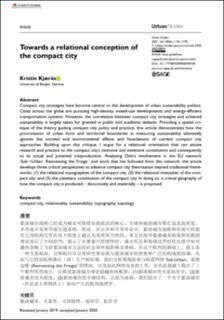| dc.contributor.author | Kjærås, Kristin Edith Abrahamsen | |
| dc.date.accessioned | 2021-08-02T11:12:04Z | |
| dc.date.available | 2021-08-02T11:12:04Z | |
| dc.date.created | 2021-03-08T11:19:46Z | |
| dc.date.issued | 2021 | |
| dc.identifier.issn | 0042-0980 | |
| dc.identifier.uri | https://hdl.handle.net/11250/2765830 | |
| dc.description.abstract | Compact city strategies have become central to the development of urban sustainability politics. Cities across the globe are pursuing high-density, mixed-use developments and energy-efficient transportation systems. However, the correlation between compact city strategies and achieved sustainability is largely taken for granted in public and academic debates. Providing a spatial critique of the theory guiding compact city policy and practice, this article demonstrates how the prioritisation of urban form and territorial boundaries in measuring sustainability ultimately ignores the societal and environmental effects and foundations of current compact city approaches. Building upon this critique, I argue for a relational orientation that can attune research and practice to the compact city’s intensive and extensive constitution and consequently to its actual and potential (re)production. Analysing Oslo’s involvement in the EU network ‘Sub>Urban: Reinventing the Fringe’, and work that has followed from this network, the article develops three critical perspectives to advance compact city theorisation beyond traditional frameworks: (1) the relational topographies of the compact city; (2) the relational intensities of the compact city; and (3) the planetary constitution of the compact city. In doing so, a critical geography of how the compact city is produced – discursively and materially – is proposed. | en_US |
| dc.language.iso | eng | en_US |
| dc.publisher | Sage | en_US |
| dc.rights | Navngivelse 4.0 Internasjonal | * |
| dc.rights.uri | http://creativecommons.org/licenses/by/4.0/deed.no | * |
| dc.title | Towards a relational conception of the compact city | en_US |
| dc.type | Journal article | en_US |
| dc.type | Peer reviewed | en_US |
| dc.description.version | publishedVersion | en_US |
| dc.rights.holder | Copyright Urban Studies Journal Limited 2020 | en_US |
| cristin.ispublished | true | |
| cristin.fulltext | postprint | |
| cristin.qualitycode | 2 | |
| dc.identifier.doi | 10.1177/0042098020907281 | |
| dc.identifier.cristin | 1896293 | |
| dc.source.journal | Urban Studies | en_US |
| dc.source.pagenumber | 1176-1192 | en_US |
| dc.identifier.citation | Urban Studies. 2021, 58(6), 1176-1192 | en_US |
| dc.source.volume | 58 | en_US |
| dc.source.issue | 6 | en_US |

